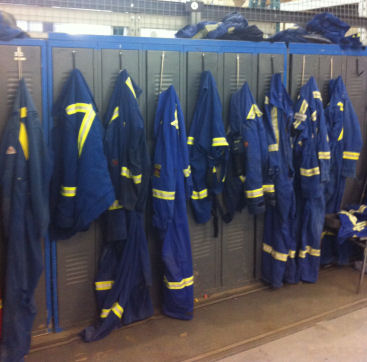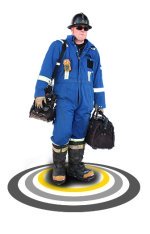Fire Retardant Clothing for Electricians
Fire retardant clothing is chemically treated to reduce the chance of catching fire. There are several types of clothing available. Which ones you need depend on the type of work you do. Firemen, for example, need to be protected from head to toe, including fire resistant boots.

Most electricians need flame-resistant sleeves and coveralls or aprons. The biggest threat of your clothing catching fire comes from an arc flash. This flash can start a fire or cause severe burns. Your arms and chest area are at the greatest risk. Fire resistant sleeves and aprons protect these areas.
Flame-resistant sleeves and aprons are worn right over your regular clothing, making them easy to slip on and off.
Safety standards are in place to let you know what type of protection you need for each type of job. There are several companies that make high quality personal protective clothing. Your local safety store will have several brands available, or you can shop online for a wider selection.
As an employee of a company, you may have all of your safety equipment supplied to you. But, some companies require you to buy certain items yourself. Since people come in many different shapes and sizes, it is easier for the company to have you buy your own coveralls or other fire retardant clothing and then reimburse you the money, rather than order the clothing for you.
When buying safety equipment, whether you will be reimbursed or not, don’t sacrifice quality for a cheaper brand. Saving a few dollars can cost you plenty in the long run.
First of all, the clothing won’t last as long, so you will be buying new stuff in no time.
Secondly, it may not provide the adequate protection you want.
The weight of your fire retardant clothing should also be a consideration. You want adequate protection, but you also want to do your job. If you are weighed down with bulky clothing you will tire out faster and you may not be able to perform your duties properly. This is can also become a safety risk.
You should never consider working without the proper gear, just make sure the coveralls and sleeves fit comfortably without excessive weight. The ideal fire retardant clothing will be lightweight and allow you to move freely.
Storage and Proper Care
There will be days when you don’t need all your personal protection gear. Storage and proper care is very important. Tossing them in the corner of your locker, especially when wet, can ruin your clothing. You should always fold them neatly or hang them up. And make sure to give them a thorough cleaning inspection before and after each use.

The last thing you want is to find your safety gear ruined by chemicals.
Most fire retardant clothing is made of nylon or cotton. The inner layer is cotton for extra comfort and the outer layer is for protection. The clothing is treated with high quality, fire resistant chemicals that are deeply impregnated into the fibers. These chemicals have been formulated to extinguish a source of ignition in order to prevent a spark from turning into a flame.
High quality safety clothing can cost you about a hundred dollars or more, so you want to take good care of them. With proper care, they should last several years. They come in a variety of colours, the most common being navy blue, royal blue and orange.
Most FR clothing can be washed in a regular washing machine. Follow the instructions on the label and never use bleach, as this may interfere with the fire resistant chemicals. And never put them in the dryer unless the label specifically says you can.
Industrial Standards
For electrical workers, fire retardant clothing is regulated by the National Fire Protection Agency standard 70E. It states that employees must wear flame resistant protective clothing whenever there may be a threat of exposure to an electrical arc flash. Industrial electricians working in the oil patch can expect to wear full body fire retardant clothing every day.
Abiding by the standard is currently voluntary, and most companies do comply. It is the generally accepted safety standard throughout manufacturing companies and the electrical industry.
The general duty clause of the Occupational Safety and Health Association states that all employers must take all necessary precautions to ensure workers are protected and their environment is as safe as possible. Companies found not to comply are fined.
The OSHA is working towards rewriting their standard in order to cover all maintenance and operations of electrical power generation, transmission, transformation, control and distribution of electrical power lines and electrical equipment to reflect the standards set out in NFPA 70E. Once the standard gains approval, compliance will be law and no longer voluntary.
When working with electricity you are in constant danger of having an arc flash land on your clothing. Protect yourself with the proper fire retardant safety clothing for your job and prevent a tiny incident from turning into a serious disaster.





